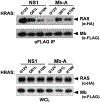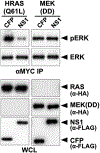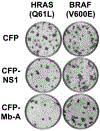Probing RAS Function with Monobodies
- PMID: 33977484
- PMCID: PMC8121162
- DOI: 10.1007/978-1-0716-1190-6_17
Probing RAS Function with Monobodies
Abstract
RAS is frequently mutated in human cancers with nearly 20% of all cancers harboring mutations in one of three RAS isoforms (KRAS, HRAS, or NRAS). Furthermore, RAS proteins are critical oncogenic drivers of tumorigenesis. As such, RAS has been a prime focus for development of targeted cancer therapeutics. Although RAS is viewed by many as undruggable, the recent development of allele-specific covalent inhibitors to KRAS(G12C) has provided significant hope for the eventual pharmacological inhibition of RAS (Ostrem et al., Nature 503(7477):548-551, 2013; Patricelli et al., Cancer Discov 6(3):316-329, 2016; Janes et al., Cell 172(3):578-589.e17, 2018; Canon et al., Nature 575(7781):217-223, 2019; Hallin et al., Cancer Discov 10(1):54-71, 2020). Indeed, these (G12C)-specific inhibitors have elicited promising responses in early phase clinical trials (Canon et al., Nature 575(7781):217-223, 2019; Hallin et al., Cancer Discov 10(1):54-71, 2020). Despite this success in pharmacologically targeting KRAS(G12C), the remaining RAS mutants lack readily tractable chemistries for development of covalent inhibitors. Thus, alternative approaches are needed to develop broadly efficacious RAS inhibitors. We have utilized Monobody (Mb) technology to identify vulnerabilities in RAS that can potentially be exploited for development of novel RAS inhibitors. Here, we describe the methods used to isolate RAS-specific Mbs and to define their inhibitory activity.
Keywords: Cell signaling; HEK293; Monobody; NIH/3T3; PEI; RAS; RAS foci; Soft agar assays; Transfection; Tumorigenesis; Xenograft tumor assays.
Figures





References
-
- Patricelli MP, Janes MR, Li L-S, Hansen R, Peters U, Kessler LV, et al. Selective Inhibition of Oncogenic KRAS Output with Small Molecules Targeting the Inactive State. Cancer Discov. 2016. March;6(3):316–29. - PubMed
-
- Janes MR, Zhang J, Li L-S, Hansen R, Peters U, Guo X, et al. Targeting KRAS Mutant Cancers with a Covalent G12C-Specific Inhibitor. Cell. 2018. January 25;172(3):578–589.e17. - PubMed
-
- Canon J, Rex K, Saiki AY, Mohr C, Cooke K, Bagal D, et al. The clinical KRAS(G12C) inhibitor AMG 510 drives anti-tumour immunity. Nature. 2019. November;575(7781):217–23. - PubMed
Publication types
MeSH terms
Substances
Grants and funding
LinkOut - more resources
Full Text Sources
Other Literature Sources
Medical
Research Materials
Miscellaneous

